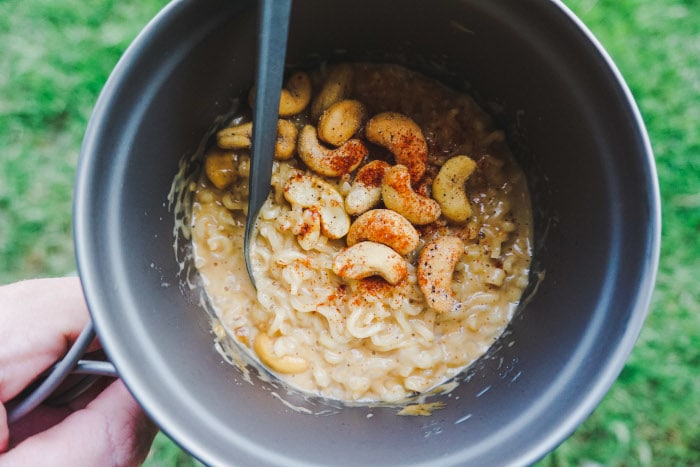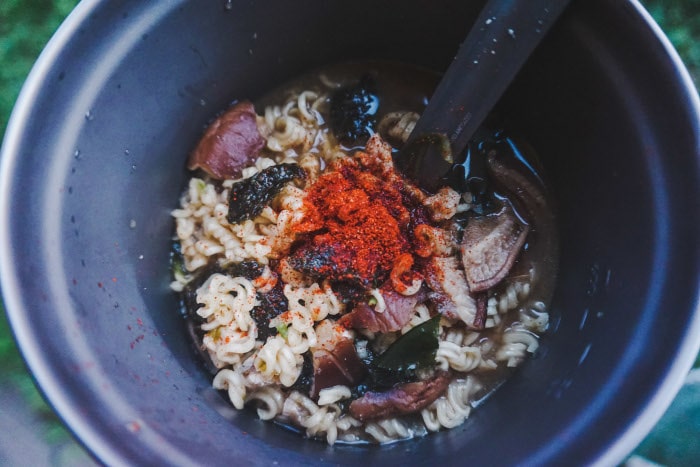When it comes to easy backpacking foods, ramen noodles still reign supreme. There might be hundreds of awesome freeze-dried meals out there, but the price, weight and ease of cooking keep ramen at the top of the list.
Another great thing about ramen is that the flavor possibilities are endless. You don’t have to stick to just the little flavor packs, and there’s a ton of room to be creative. The things you can do with it are downright gourmet by any backpackers’ standard, so I put together some of the best recipes to keep your food rotation interesting.
These recipes involve some actual cooking on trail, which I'm a fan of doing at dinner time. But lunchtime is another story, so if you need some easy no-cook backpacking lunches then check out this post.
Note: As an Amazon associate I earn from qualifying purchases. If you click through one of the links on this page and make a purchase, we receive a small kickback at no extra cost to you. It helps keep us up and running and able to continue to provide great content. 🙂
Quick Cooking Tips
Before I get to the recipes, I want to go over some quick tips to improve any backcountry meal. Hunger is still the best seasoning, but often it's sworth making a few small adjustments to eat like a king on the trail. (If you just want to skip to the recipes, click here)
Tip #1: Fry Your Spices
I know this sounds unnecessary, but frying your spices in oil before adding water to the pan can give you a huge flavor boost. Frying even pre-ground spices brings out characteristics that would otherwise go untapped. And, because your spices are already ground, it only takes about a minute of frying in oil to improve the flavor by a ton.
To do it: Heat olive oil in the bottom of your cookpot, add spices, and cook until aromatic (usually 1-2 minutes). Be prepared to add water quickly, because spices can burn easily.
Tip #2: Bring Fresh Ingredients Whenever Possible
Okay, so I know bringing fresh food isn't always realistic. But when possible, fresh foods can add quality to backpacking meals that you just can't get any other way.
In general, the biggest flavor bang for your buck by far will be a fresh onion. Whole onions are shelf stable, they go with almost any savory meal, and all you have to do is chop them up and saute in oil before adding water to the pan. I watch my pack weight pretty closely, but I still find myself bringing onions when flavor is a priority.
Tip #3: Use plenty of dehydrated vegetables
Adding vegetables and meats makes for a much more nutritious meal that will digest better than your typical "ramen bomb." I always feel more satisfied and recharged when I eat a meal full of vegetables than one that's simple carbs only (as ramen and other easy meals are so apt to be).
As far as vegetables go, Harmony House Foods is my go-to. They have tons of options to choose from and you can easily mix and match veggies to your liking. Plus, their flavor and freshness quality is unmatched in the dehydrated food world. All of their foods feel like something you picked from the garden and dehydrated yourself, and I highly recommend them.
Tip #4: Don't Skimp on The Salt
When backpacking, you go through a lot of salt during the day due to sweating. You need to replenish it, and while many pre-made backpacking foods are plenty salty, it's easy to forget that you'll often want extra when making your own.
I think your body knows when you need salt, and adding a little more than usual to your meals will make them taste extra good (use kosher or sea salt for even more flavor). You'll have to experiment to find the sweet spot, but make sure to always bring plenty of it.
Tip #5: Add A Little Acid To Brighten Any Flavor
It's not necessarily intuitive, but adding little acidity can do more to improve the flavor of a meal than just about anything else you can do. Lemon juice literally makes your mouth water, and adds complexity to everything from tomato sauce to stroganoff.
The beauty of this trick when it comes to backpacking is that you can substitute real lemon juice for lemon powder (like these single serve packets, from True Citrus), which weighs next to nothing. Buy a box and throw the packets in your mess kit for whenever you need a flavor boost. And you can easily use them as a water enhancer as well, something that I greatly appreciate when water sources are less than ideal.
1. Coconut Curry Noodles
If you like curry, you’ll love these noodles. The secret to the delicioussness is to saute the oil and curry powder first, because that’s where a ton of the flavor comes from. The coconut milk powder can be left out and it’ll still be pretty good, but we highly recommend using it. Coconut milk is essential in real curry, and it’s what takes this dish from ‘good’ to ‘amazing’. You can get the powder on Amazon here (1lb will last about 30 recipes, and it’ll add depth and flavor to just about anything you put it in; trust me, it’s worth it).
Ingredients
- 2 tbsp curry powder
- 2 tbsp sesame oil (or olive oil)
- 1 tsp garlic powder
- 1 tsp onion powder
- 2 tbsp coconut milk powder
- 1/2 cup dried veggies (optional but recommended, pick your favorites here)
- 1/2 cup dehydrated chicken (or protein of choice)
- 1 package chicken flavored ramen noodles (or match flavor to protein choice)
Directions
At home: Combine garlic powder, onion powder, coconut milk powder, veggies, and meat and put in a ziploc or reusable bag. Put curry powder into a separate bag, and put olive oil in a 2oz plastic HDPE bottle (like these; avoid using the kind with the dropper top, as they have a tendency to leak oil).
At camp: Add oil and curry powder to pot and saute on low 2-3 minutes. If you don't have simmer control it'll still work, you'll just have to watch it closely to prevent burning.
Add 1.5-2 cups of water (depending on how thick you like your sauce) and add all the dry ingredients. Simmer for 4-5 minutes, making sure the meat and veggies are rehydrated. Then add the ramen (and flavor packet) and cook according to directions (usually about 3 minutes). Remove and enjoy.
2. Thai Style Peanut Noodles

I discovered thai-style peanut noodles in college, and I made them about 50 times that year. They’re amazing, and this recipe (straight from the legend Andrew Skurka himself) hits the nail on the head. It requires a little bit more prep work than some, but I think it’s well worth it. The peanut sauce is rich, creamy, and flavorful, and I guarantee you’ll want to bring it on every trip.
Ingredients
- 1/4 cup peanut butter
- 1 tbsp sesame oil
- 1 tbsp soy sauce
- 1 tbsp honey
- 1 tsp garlic (or garlic powder)
- 1 pinch ginger powder
- 1 tbsp coconut milk powder (optional, but adds calories and flavor)
- peanuts or cashews
- salt, pepper, and red pepper flakes to taste (if you like it a little spicy)
- 1 package ramen noodles
Directions
At home: Combine everything but the ramen and peanuts/cashews and stir to blend. It's easier if you're making sauce for more than one serving, but you can do this for single servings as well. Store in a 2 oz (or whatever size is necessary for your group) HDPE bottle.
At camp: Add 1.25-1.5 cups water to your pot and bring to a boil. Add ramen and cook 3-5 minutes. Remove from heat, add sauce and cashews, stir to combine, and enjoy.
3. Japanese Restaurant Style Ramen

This is what ramen noodles are supposed to taste like. It’s a restaurant style recipe, packed with rich japanese flavors and goodness. Authentic Japanese ramen is one of my favorite foods of all time, and this is about as close as you can get while backpacking (though I'm still working on the hard-boiled egg part).
Ingredients
- 1/2 cup dried shiitake mushrooms
- 1 tbsp sesame oil
- 1 tbsp soy sauce
- 1 chicken boullion cube
- miso soup mix (can be found in the Asian section of grocery stores, or here)
- 1 tbsp garlic (or garlic powder)
- Nori Seaweed (often comes in single serve packs, like these)
- Dried tofu (if not already included in miso pack)
- 1 True Lime (or True Lemon) packet
- red pepper flakes to taste
- 1 package ramen noodles
Directions
At home: Remove mushroom stems, chop/dice into smaller pieces, and put in a plastic bag or container with the dried tofu.
Combine soy sauce, sesame oil, and garlic and store in a 2oz HDPE container.
At camp: Add sauce mix to your pot and simmer until fragrant, 1-2 minutes. Add miso mix, mushrooms and 1.5 cups water to your pot and bring to a boil. Simmer for 3-5 minutes to allow the mushrooms to tenderize. Add ramen and cook 3-5 minutes. Add True Lime packet and nori pieces (rip them to make them smaller) and remove from heat. Add salt, pepper, and red pepper flakes to taste and enjoy.
4. Backpacker's Spaghetti
You thought Mountain House was the only backpackers spaghetti name in town? Well it turns out you can DIY this one, and it’s actually pretty easy and super delicious. For this one I highly recommend making room for all the ingredients, because they’re all important for real spaghetti. I promise it’s worth it, and it helps that all of the powdered stuff and spices can be combined at home.
Ingredients
- 3 tbsp tomato powder (can be found at Harmony House or here)
- 2 tsp italian seasoning
- 1 tsp salt or garlic salt
- 1 tsp garlic powder
- 1 tsp onion powder
- 3 tbsp powdered parmesan
- 1/4 cup each of dried onions and dried spinach (optional but highly recommended)
- 1/4-1/2 cup dehydrated ground beef (or TVP, available at Harmony House)
- 1 tbsp Worcestershire sauce
- 2 tbsp olive oil
- 1 package ramen noodles
Directions
At home: Combine tomato powder, italian seasoning, salt, garlic powder, and onion powder and store in a plastic bag/container.
Combine dried veggies and meat and store in a plastic bag/container (these can also be stored in the same container as the spice mix if you prefer).
Combine olive oil and worcestershire and store in a 2oz HDPE bottle.
Store parmesan in a plastic container.
At camp: Add 1.5 cups of water, spice mix, meats and veggies, and oil/worcestershire to your pot and simmer 3-5 minutes to allow the meat/veggies to tenderize. Make sure to stir to prevent scorching. Add ramen noodles and cook 3-5 minutes. Remove from heat, add parmesan, red pepper flakes, salt and pepper to taste and enjoy. (Disclaimer: sauce will be slightly runny by normal spaghetti standards, but it tastes delicious).
I hope you enjoy these recipes! They've been rigorously experimented with to get them where they are, and I'm excited to share them with you. But, of course, nothing is ever perfect, and people’s tastes vary a lot. So if you have recipe suggestions, edits, or tips/tricks, I’d love to hear them in the comments!
